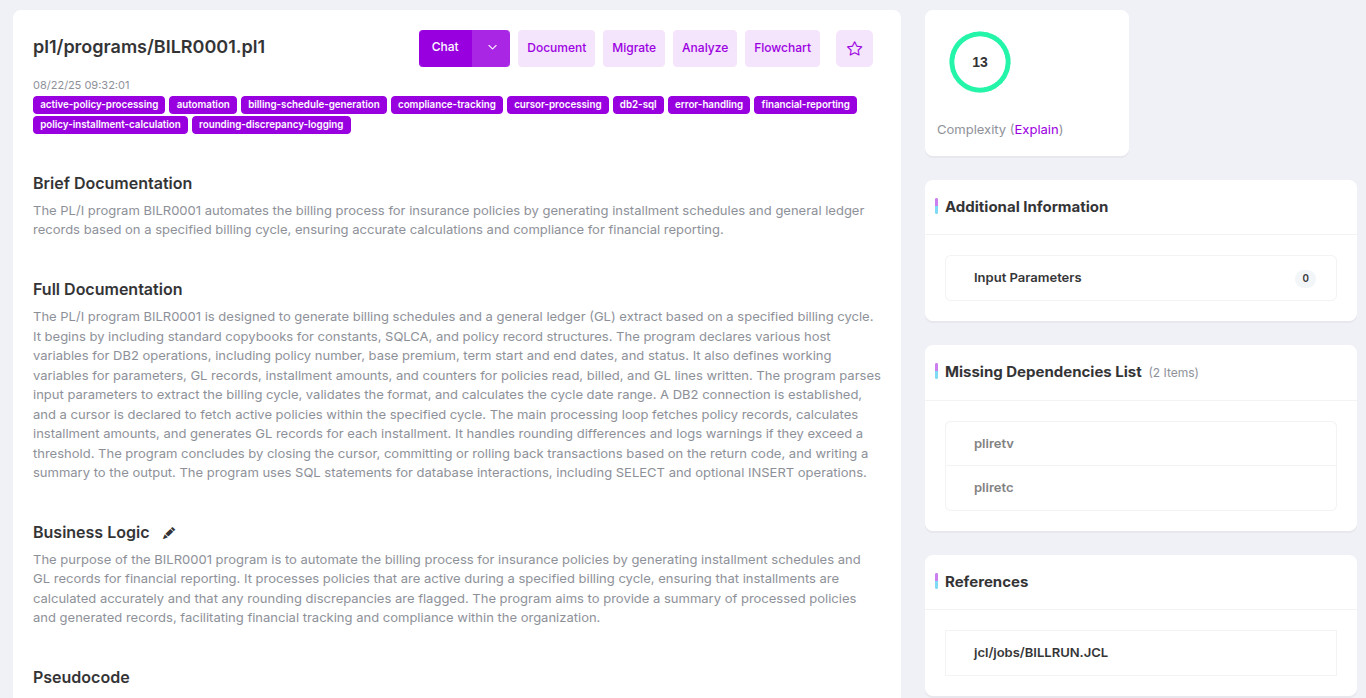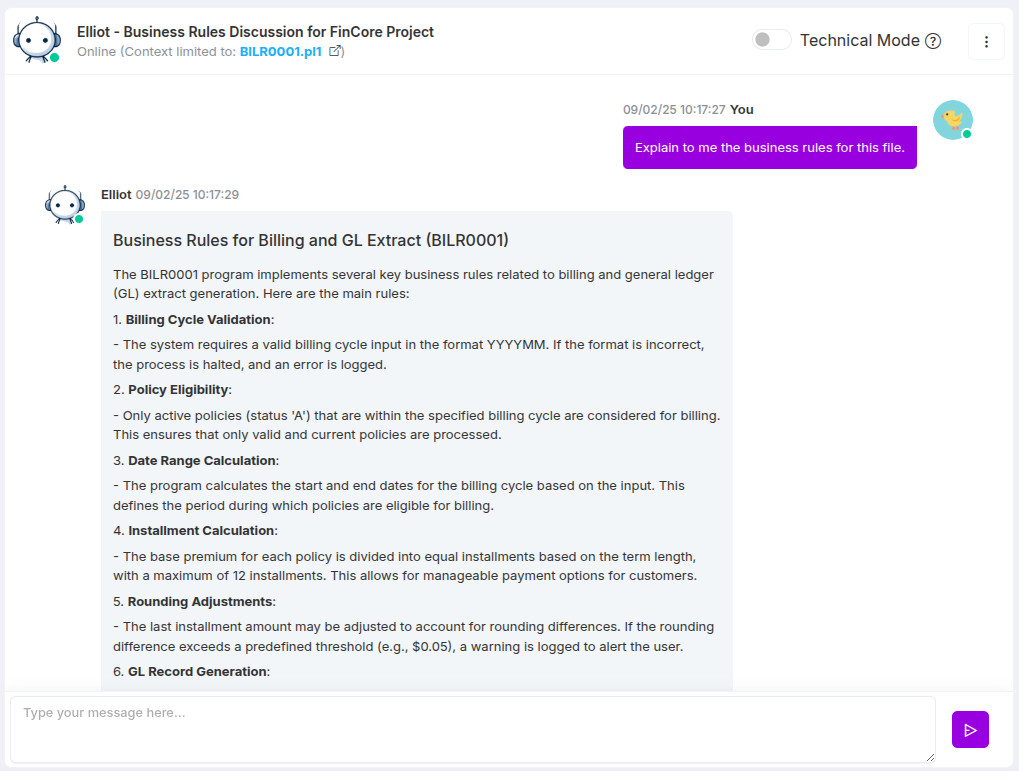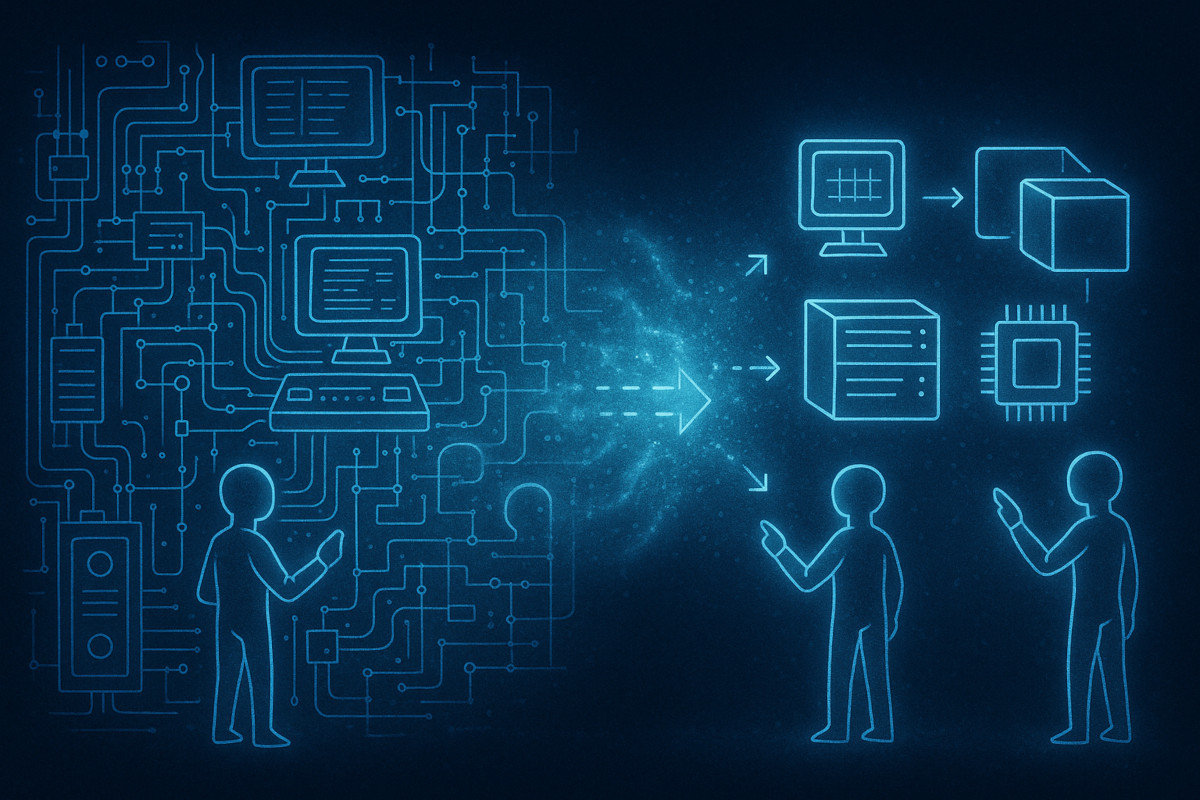The Hidden Risk in PL/I Systems: Knowledge Loss and Compliance Exposure
For many regulated enterprises, PL/I systems represent a double-edged sword: foundational to operations yet opaque and increasingly brittle. Originally chosen for its powerful data-handling capabilities and structured syntax, PL/I still underpins mission-critical applications in sectors like banking, insurance, and government. However, decades after their inception, these systems are now facing a profound knowledge crisis.
The root of the problem lies in the people. The original architects of these PL/I systems are retiring, taking with them years of institutional knowledge that was never fully documented. Meanwhile, new developers face steep learning curves, often working without any reliable references, let alone up-to-date documentation. In large environments, it’s not uncommon to find PL/I files that haven’t been modified—or even fully understood—in over a decade.
This growing knowledge gap isn’t just a technical inconvenience; it’s a material risk. Enterprises under regulatory scrutiny—HIPAA in healthcare, Basel IV in banking, or NIST in government contracts—are finding it harder to map legacy logic to compliance frameworks. Without traceable documentation of business rules, data lineage, and interdependencies, auditability becomes a guessing game. Worse, system changes—however minor—can trigger unintended downstream effects, jeopardizing both uptime and compliance posture.
Modernization may be the end goal, but documentation is the first step. Enterprises that fail to treat PL/I documentation as a strategic imperative risk not only operational disruption but regulatory penalties and rising TCO. This is where AI-driven documentation solutions, like those offered by CodeAura, come into play—automating the discovery, contextualization, and ongoing maintenance of legacy knowledge.
Why Traditional Documentation Falls Short in Legacy Environments
Legacy environments are uniquely hostile to conventional documentation efforts. Teams attempting to manually document PL/I systems often run into three core challenges: scale, context, and continuity.
First, the scale is overwhelming. Many enterprises operate with thousands of PL/I files woven into larger systems that include COBOL, JCL, DB2, and custom scripts. These files often contain intertwined business logic with little modularization or naming consistency. Manually documenting this landscape would take years—assuming you had the right experts on hand.
Second, context is missing. Traditional documentation tends to focus on the “what” (file names, variable definitions, etc.) but rarely captures the “why”—the business intent behind the code. This gap makes it nearly impossible for newer teams to understand the rationale for a process, especially in regulated industries where decisions must align with policy or compliance frameworks. Without system-wide context, code comprehension becomes fragmented, and dependencies are routinely missed.
Finally, continuity is fragile. Even well-intentioned documentation efforts degrade quickly. Code evolves. Personnel change. Versioning tools aren’t always integrated across legacy platforms. As a result, traditional documentation is often obsolete by the time it’s completed.
This trifecta of problems undermines confidence in the documentation itself. Developers revert to code spelunking. Architects operate from tribal knowledge. Compliance officers struggle to reconcile system behavior with policy. The result: slower delivery cycles, higher error rates, and increased audit risk.
This is precisely where automation becomes critical. The next evolution of documentation isn’t just about capturing what exists—it’s about building living knowledge systems that adapt, answer questions, and stay current.
AI-Generated Baseline Documentation: Bringing Order to Legacy Chaos
Automated baseline documentation is a foundational step toward reclaiming control over PL/I environments. Rather than relying on outdated wikis or brittle spreadsheets, CodeAura applies AI-driven analysis to create a structured, living record of PL/I assets—down to the variable, function, and inter-system call level.
This is more than just syntax parsing. CodeAura’s platform leverages contextual code understanding to build comprehensive documentation layers that mirror how developers and auditors think. For example, it doesn’t just list PROC statements—it maps them to business workflows, highlights external file dependencies, and links downstream impacts across COBOL and JCL files. This system-wide traceability is vital in regulated sectors, where a single change can ripple across compliance boundaries.
Key deliverables include:
- Flowcharts that visually map control flow and decision logic within PL/I files
- Component diagrams that show how PL/I modules interact with databases, queues, and batch processes
- Data lineage tracking from input sources through transformation layers to output destinations
- Glossary-style definitions of key variables, constants, and configuration elements
What makes this documentation truly operational is that it’s generated, versioned, and maintained automatically. When code changes, the documentation updates accordingly—no human intervention required. This not only reduces maintenance overhead but ensures that teams are always working with accurate and audit-ready knowledge.
For organizations dealing with audit pressures or preparing for modernization, this baseline becomes a strategic asset. It enables faster onboarding of developers, smoother handoffs across teams, and a measurable reduction in system fragility. It’s not just documentation—it’s infrastructure for understanding.

From COBOL to PL/I: Unified Contextual Analysis Across Legacy Stacks
In real-world enterprise systems, PL/I rarely exists in isolation. It cohabits with COBOL programs, JCL scripts, VSAM files, DB2 databases, and a mix of shell scripts and third-party tools. The challenge isn’t just documenting PL/I—it’s understanding how it fits into the broader legacy ecosystem.
CodeAura addresses this complexity through unified contextual analysis. Rather than analyzing PL/I files as standalone entities, the platform parses and correlates them across the entire legacy codebase. This allows enterprise teams to see not just what a PL/I program does, but how it connects to upstream data, downstream business logic, and cross-functional systems written in entirely different languages.
For instance:
- A PL/I program might rely on a COBOL batch job for input preparation—CodeAura maps that dependency automatically.
- JCL jobs might be orchestrating PL/I and COBOL components—these workflows are captured in a unified execution model.
- Regulatory logic might span multiple programs—CodeAura can trace business rules across PL/I and COBOL boundaries and associate them with relevant compliance controls (e.g., Basel IV liquidity coverage or HIPAA data access policies).
This unified view is particularly valuable for impact analysis, where understanding the blast radius of a change is essential. It’s also critical for modernization planning, allowing architects to prioritize migration efforts based on interconnectedness, risk exposure, and code criticality.
In effect, CodeAura doesn’t just document code—it reverse-engineers enterprise logic, regardless of where it lives. This eliminates blind spots, reduces dependency risk, and lays the groundwork for future-proof modernization.
Documentation You Can Talk To: Interactive Q&A for Real-Time Clarity
Static documentation—even when comprehensive—isn’t always enough in high-stakes legacy environments. Developers need real-time answers. Architects want to validate assumptions quickly. Compliance teams require fast traceability during audits. This is where CodeAura’s interactive Q&A documentation model changes the game.
By embedding AI-powered assistants directly into platforms like Slack, JIRA, or custom interfaces, CodeAura transforms PL/I documentation into an always-available, conversational knowledge layer. Instead of hunting through PDF files or wading through nested folders, users can simply ask:
- “What happens if I change this variable in PLIPROC01?”
- “Which PL/I programs write to the customer_info VSAM file?”
- “Show me business rules related to loan disbursement in PL/I.”
Behind the scenes, CodeAura’s contextual engine understands the full structure and semantics of the codebase. It not only pulls accurate, real-time answers but explains them in natural language, backed by linked references to source code, flowcharts, and documentation.
This Q&A approach democratizes legacy knowledge:
- For developers, it accelerates onboarding and reduces dependency on SMEs.
- For architects, it supports deeper system understanding without manual tracing.
- For compliance and risk teams, it enables fast verification of controls and dependencies.
The impact is tangible. Enterprises using interactive documentation models have seen reductions of up to 40% in developer onboarding time, and significantly fewer errors during code changes. More importantly, this approach transforms documentation from a static artifact into a living, queryable interface—bridging the gap between legacy complexity and modern agility.

Driving Developer Productivity with Hybrid Documentation Models
Enterprise teams working in PL/I environments often operate under tight timelines, fragmented knowledge, and opaque codebases. In this context, a hybrid documentation model—combining static AI-generated baselines with dynamic Q&A capabilities—proves not just helpful, but essential for scalable productivity.
CodeAura’s approach recognizes that different users have different documentation needs:
- A new developer onboarding to a claims processing system might need a visual overview of the program flow and key data interactions.
- A senior engineer refactoring a data pipeline may want precise, line-level explanations and dependency maps.
- A project manager preparing for a system upgrade might require summarized business logic and audit-readiness reports.
By delivering both static and interactive formats, CodeAura enables all stakeholders to engage with PL/I systems on their terms—without bottlenecks.
The static documentation layer offers:
- Readily accessible overviews and technical details
- Flowcharts and diagrams for architectural clarity
- Automatically updated artifacts synced with code changes
The interactive layer brings:
- Conversational access to deep technical insight
- Instant answers to dependency, logic, and compliance questions
- Integration into existing tools and workflows (e.g., Slack, JIRA)
Together, these models significantly reduce the friction associated with legacy development. Teams can shift from reactive problem-solving to proactive system understanding. As a result, enterprises often report:
- 30–50% faster development cycles on legacy systems
- Fewer regressions and outages during change implementations
- Improved morale and collaboration across tech and business teams
This hybrid approach doesn’t just make legacy systems tolerable—it makes them transparent, actionable, and resilient, all while laying the groundwork for modernization.
Regulatory Mandates Made Visible: HIPAA, Basel IV, and Audit Alignment
Legacy systems like those built on PL/I often represent hidden compliance liabilities. Business-critical logic embedded in these systems drives decisions about patient data, financial transactions, and customer eligibility—but without clear documentation, enterprises struggle to prove alignment with regulatory standards like HIPAA, Basel IV, and NIST.
CodeAura changes this by making regulatory exposure visible and traceable. Through AI-assisted tagging and semantic analysis, the platform automatically associates PL/I logic with relevant compliance domains. For example:
- In a healthcare context, it can flag routines accessing protected health information (PHI) and map them to HIPAA security rules.
- For banks under Basel IV, it can identify code paths that influence capital calculations or liquidity thresholds, surfacing key controls for audit.
- In federal systems, it can track access control mechanisms to ensure NIST 800-53 compliance across legacy execution flows.
These mappings aren’t hardcoded—they evolve with the system. As PL/I programs are updated or integrated into modern environments, CodeAura keeps documentation and compliance tagging in sync. This creates a living audit trail that supports:
- Pre-audit readiness: Generating clear, verifiable documentation for auditors
- Change impact assessments: Understanding how updates may affect regulated logic
- Risk mitigation: Proactively identifying gaps or conflicts in control implementation
The result is not only better compliance outcomes but also reduced audit fatigue and faster incident response. Enterprises gain confidence that their legacy systems aren’t just functional—they’re governable, a prerequisite for long-term digital transformation.
From Insight to Action: Paving the Path to PL/I Modernization
While documentation is often seen as a defensive necessity, in the context of legacy modernization, it becomes a powerful strategic enabler. For enterprises still dependent on PL/I systems, robust, AI-driven documentation—both static and interactive—lays the foundation for a seamless transition from legacy to modern.
CodeAura equips organizations not just with insight, but with actionable clarity. By decoding PL/I systems at scale and in context, the platform allows teams to:
- Prioritize modernization targets based on complexity, risk, and business value
- Decompose monolithic PL/I programs into modular components for microservice rearchitecture
- Feed clean documentation into migration tools, accelerating transformation to Java, JavaScript, or cloud-native platforms
- Retain institutional knowledge, reducing reliance on retired SMEs or third-party contractors
This isn’t just about migrating code—it’s about preserving the business logic that has powered the enterprise for decades, while preparing it for the future. The combination of static clarity and dynamic Q&A capabilities means stakeholders—from CIOs to line developers—can make informed, coordinated decisions about how and when to modernize.
Moreover, the gains are measurable. Enterprises using CodeAura’s hybrid documentation model have seen:
- 60–70% faster planning cycles for legacy migration
- 40%+ reduction in modernization rework due to clearer system understanding
- Up to $500K in annual audit cost savings by automating compliance mapping
Modernization starts with knowing what you have. With CodeAura, PL/I systems—once black boxes—become fully illuminated assets, ready to evolve.
Let’s Talk About Your PL/I Documentation and Modernization Needs —
Schedule a session with CodeAura today.




